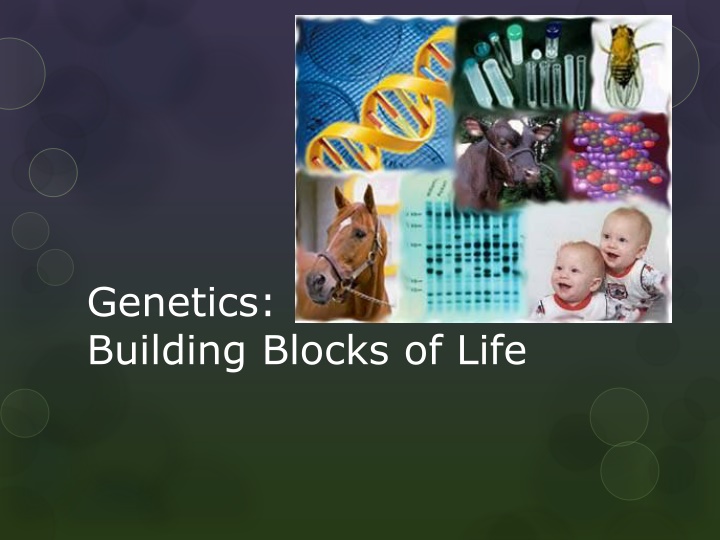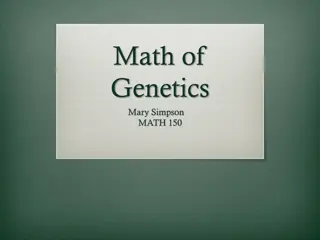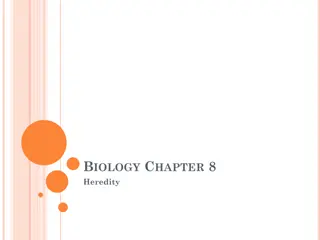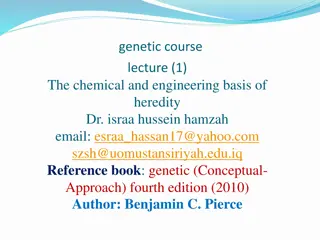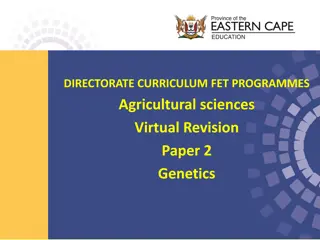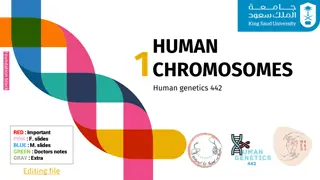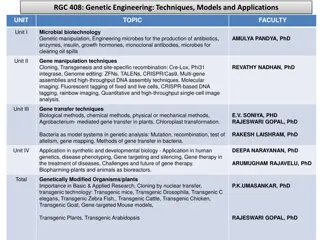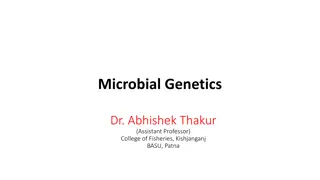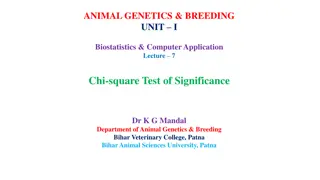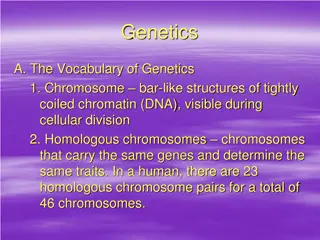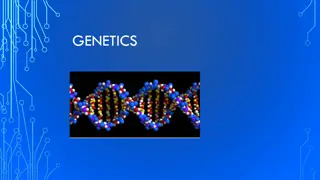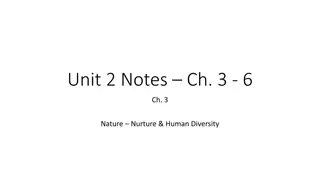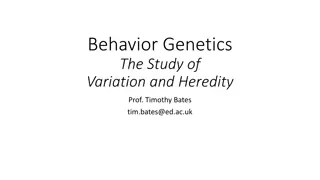Genetics: The Blueprint of Life
Genetics is the study of heredity and how traits are passed from parents to offspring. It involves understanding genetic makeup (genotype) and physical attributes (phenotype) determined by genes. Mendel's laws of segregation and independent assortment explain how alleles and traits are inherited. Nucleic acids, DNA and RNA, are essential for storing and transmitting genetic information. Understanding nucleotides, bases, and their functions provides insight into the genetic code.
Download Presentation

Please find below an Image/Link to download the presentation.
The content on the website is provided AS IS for your information and personal use only. It may not be sold, licensed, or shared on other websites without obtaining consent from the author.If you encounter any issues during the download, it is possible that the publisher has removed the file from their server.
You are allowed to download the files provided on this website for personal or commercial use, subject to the condition that they are used lawfully. All files are the property of their respective owners.
The content on the website is provided AS IS for your information and personal use only. It may not be sold, licensed, or shared on other websites without obtaining consent from the author.
E N D
Presentation Transcript
Genetics: Building Blocks of Life
What is Genetics? Heredity: the passing of traits from parents to offspring Biological Inheritance Genotype genetic makeup of an organism Phenotype physical attributes determined by genotype Gene: Unit of heredity that determines trait DNA products RNA products Protein products Alleles: different forms of a gene Dominant allele only one copy is required to be expressed Recessive allele both copies are required to be expressed Chromosome: strand of DNA containing genome of organism
Law of Segregation Gregor Johann Mendel, 1865 First Law of Mendelian Genetics For every allele, you receive one maternal and one paternal allele to have a full pair Each allele is randomly selected Gametes: sex cells of sexually reproducing organism are haploid cells two gametes fuse together to produce diploid cell during fertilization Haploid: having only one of a pair of each chromosome Diploid: having two of a pair of each chromosome
Law of Independent Assortment Second Law of Mendelian Genetics Each trait that goes with an allele is independent from other alleles and traits Alleles of different genes sort independently of each other during gamete formation
What are Nucleic Acids? DNA: Deoxyribose Nucleic Acid RNA: Ribose Nucleic Acid Nucleotide: Base, Sugar, Phosphate Why two different Nucleic Acids?
All about Nucleic Acids 3 components Backbone made of ribose sugar for RNA or deoxyribose for DNA and a phosphate group Base determined by carbon and nitrogen rings Purine and Pyrimidine Bases: Adenine, Guanine, Cytosine, Thymine, Uracil The order of the bases in the DNA strand determines the genetic code Functions Store genetic information Transmit genetic information Encode protein products
Nucleic Acids Stick Together Nucleotides have Hydrogen bonds that pair them together to make complementary strands Pyrimadines: 1 ring of carbon and nitrogen Adenine has two bonds to Thymine Purines: 2 rings of carbon and nitrogen Guanine has three bonds to Cytosine In RNA, Adenine has two bonds to Uracil
DNA Structure Double helix prevents damage to genetic information
DNA vs. RNA DNA Hard copy of Genetic Code Stays inside cell nucleus Mutations can become permanent RNA Temporary working copy of Genetic Code Transports into cytoplasm to ribosomes Less stable molecules do not last as long Ribose sugar not as stable as deoxyribose Single strand not as stable as double helix
The Central Dogma DNA and RNA and Protein DNA replication: semi-conservative replication producing two identical double helices Transcription: DNA directed production of RNA Translation: RNA directed production of protein File:Centraldogma nodetails.GIF http://upload.wikimedia.org/wikipedia/en/thumb/d/dd/Extended_Central_Dogma_with_Enzymes.jpg/550px-Extended_Central_Dogma_with_Enzymes.jpg
Transcribe vs. Translate Transcription: RNA Polymerase uses the complementary strand of DNA to make a copy of the template DNA into a strand of RNA Translation: Ribosomes use the message strand of RNA to make a protein chain of amino acids
The Genetic Code 3 bases of RNA make up a Codon Codon of messenger RNA pairs with Anti-codon of transfer RNA during transcription to determine amino acid sequence Genetic code is redundant, but not ambiguous
Expressing your Genes Copy Number: increased number of RNA messages increases gene product Determined by strength of Transcription promoter sequence Regulatory Genes: repress or activate expression of other genes Transcriptional Regulation: regulatory molecules activate or repress transcription through promoter sequence Post-Transcriptional Regulation: Translation: regulatory molecules activate or repress translation through degradation, phosphorylation, methylation or other methods Feedback inhibition: product of pathway inhibits pathway
Mitosis Cellular Division: one cell copies all genetic material and divides into two separate identical cells Diploid cell with one copy of the chromosomes replicates to -> diploid cell with two copies of the chromosomes divides to -> two diploid cells with one copy of the chromosomes
Meiosis Gamete Formation: Cell division involved in production of gametes 2 cellular divisions resulting in four haploid daughter cells Diploid cell with one copy of the chromosomes replicates to -> diploid cell with two copies of the chromosomes divides to -> two diploid cells with one copy of the chromosomes divides to -> four haploid cells with one copy of chromosomes
Why sexual reproduction? Asexual reproduction can only produce identical copies Sexual reproduction allows variation in offspring Multiple phenotypes in offspring ensures the survival of some offspring if one of the phenotypes is selected against
Linkage The joint inheritance of genes or alleles due to physical linkage on the same chromosome during meiosis Sex linkage: expression of an allele that is related to the chromosomal sex of an individual typically more X-linked traits inherited than Y- linked traits in humans
Examples of Sex Linked Characteristics In Humans: Hemophilia on X chromosome In Cats: Calico Coat Color on X chromosome In Cattle: Streaked Hairlessness in Holsteins on X chromosome
How to: Punnett Squares Monohybrid cross looking at one pair of alleles controlling one trait to determine possible progeny Dihybrid cross looking at 2 pairs of alleles for a total of two traits to determine all possible progeny
Example Punnett Square Dihybrid Sex-Linked Cross The mother cat has Calico coat color (Black and Orange) and blue eyes; her genotype is XR Xr bb Father cat has a Black coat and green eyes: Xr Y BB Progeny: Calico coat, green eyed female: 25% Orange coat, green eyed female: 25% Black coat, green eyed male: 25% Orange coat, green eyed male: 25 % Total Offspring: 50% orange coat, green eyes 25% black coat, green eyes 25% calico coat, green eyes
Example Punnett Square Dihybrid Cross Assume a species of Angus cattle has two different alleles for a gene conferring body color and two different alleles for horn length. Allele B when inherited gives an black body coat, and is dominant to allele b , which gives a red body coat when inherited. Allele H when inherited gives an long horn, and is dominant to allele h , which gives a short horn when inherited. If a heterozygous black-colored long horn male (BbHh) mates with a red-colored long horn female (bbHh), what will be the phenoytpes of their progeny and what is the ratios?
Punnett Square Answers 6 black coat long horn : 2 black coat short horn : 6 red coat long horn : 2 red coat short horn
Genetic Recombination Homologous recombination of DNA during Meiosis This allows for even more genetic variation in a population by moving genes onto different chromosomes The order and the linkage of genes can change on a chromosome
Genetic Variation Genetic Variation in a population allows traits to be specifically selected for a desired outcome
Mutants all around Single Nucleotide Polymorphisms: one base pair in the DNA sequence is changed Silent Mutations no change to the codon Missense Mutations changes the codon resulting in loss or change of function of the protein product Nonsense Mutations changes the codon into a stop codon resulting in a shorten protein Frame-shift Mutations A base pair is removed or added, changing the entire sequence of amino acids
Non-Mendelian Inheritance Any effect to the inheritance that does not fit in with the two laws of Mendel Linkage and recombination are two examples of effects that change the expected offspring ratio Extra chromosomal inheritance is another example, from DNA in the mitochondria or chloroplasts
Learn Techniques: DNA fingerprinting A sample of DNA is used to determine if another sample is from the same organism, a related organism, or a non-related organism Repeating patterns of DNA are analyzed for similarities
Learn Techniques: Genetically Modified Organisms Direct manipulation of DNA to change the phenotype of an organism Genes that are synthetically made or obtained from other organisms are used to produce the desired phenotype through recombination This can be used for practice in Medicine, Research, Industry, and Agriculture
Golden Rice 2: Spring 2005 Used phytoene synthase gene from corn to increase beta-carotene 20X Can realistically prevent vitamin A deficiency by consumption of rice
Learn Techniques: Chromosomes Chromosomal Analysis: studying the number and structure of the chromosomes Also called Karyotyping
Learn Techniques: Directed Selection Cattle Traits Trait Growth to weaning Moderate Post weaning growth Efficiency of gain Carcass quality Milk production Udder structure Height Fertility Calving ease Docility Mature size Cattle are typically bred for either milk production or meat production Traits for each purpose will be selected for to produce the best quality offspring for that purpose Heritability High High Very High High Moderate High Low Moderate Moderate High E.g. A good cow for milk production will be bred if she has superior qualities of milk production, udder structure, and docility in hopes that her offspring will carry these traits as well
